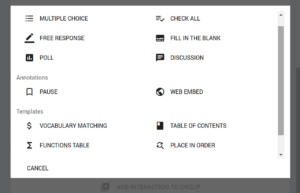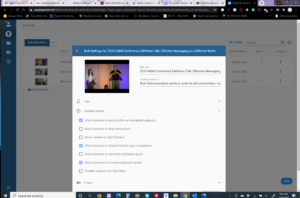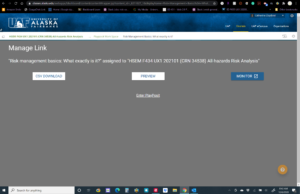I currently teach a course in All-Hazards Risk Assessment for the Homeland Security and Emergency Management Major within the UAF School of Management. The course is offered asynchronously through Blackboard and attracts students across the US. It is intended for seniors although there are some who do take it a bit earlier in the sequence. There is only one prerequisite for the course – HSEM F301 Principles of Homeland Security & Emergency Management.
Given that the course is asynchronous, I notice that I don’t have the ability to course correct or reinforce certain concepts in real-time. When I inherited the class in Fall 2017, it was strictly a series of discussion boards and exercises. Over the past few years, I have made several changes to the class, including moving away from Blackboard discussion boards. While I tried changing the grading rubrics for the discussion boards and updating the questions, I found the answers to be too stilted and both annoying and boring to grade.
I moved to Slack about 3 semesters ago which provides for a bit more interaction, although I haven’t set it up to reward the interaction of responding to other classmates since I have found that difficult to grade. I decided to use Slack to introduce topics on risk communication over the full semester. That topic had previously been a single week’s exercise, but the topic is so robust that it could justify a course of its own. Students are given Slack assignments weekly and the point allocations are such that students could choose not to do this part of the course and still end up with a B if they do everything else well. I do occasionally get feedback from students who are conditioned to only use Blackboard for their schoolwork that they dislike having to use two platforms. My usual response is to say “You’re welcome” since their future real world is more likely to include Slack than Blackboard. However, I am sensitive to the fact that many of my students are saying that to enhance their efficiency as they are taking 4 classes a semester in order to be eligible for financial aid. Given that the course really hasn’t rewarded class interaction and that I continue to think about how to support an overall community for both current students and graduates, I hypothesized that PlayPosit might prove to be an easier way to focus on developing and increasing class interaction without having to give up Slack.
I selected PlayPosit since it integrates with Blackboard as I’d like to see if I can use it for two different purposes:
- To check for understanding periodically throughout the semester and
- To encourage class discussion.
PlayPosit is a tool that provides for interactive learning for multiple mediums including K-12, undergraduate, and corporate in multiple options as indicated below:
PlayPosit refers to each stand-alone interactive video as a “bulb” as a play on the word “lightbulb”.
I had migrated my current class to my future class last week so I had the class template ready to go. Note that I still need to update the course for next semester, but since the course is not currently available to students, it’s still my sandbox. I created a new folder called “PlayPosit Work Space”. After I created the link between Blackboard and PlayPosit based on these instructions, I had a content file called “PlayPosit links” as well as direct access to PlayPosit.org where I did the actual bulb development.
I decided to develop three different bulbs in PlayPosit to evaluate its capabilities. One bulb was developed using a Kaltura video I had created earlier this year and two bulbs were created using preexisting youtube videos. Note that there are several interactive video options as one is creating the link, as indicated below:
Introduction to the critical infrastructure and hazard/threat selection exercise.
This bulb uses a Kaltura video that I created earlier in the semester. It’s about the initial assignment of a 7-part project that results in a decision brief at the final deliverable. Each of the 6 prior assignments allows them to build pieces of the puzzle that are then assembled and presented to stakeholders. I have played with a number of different ways in which to clarify the expectations for this assignment since I do have strict implementation guidelines. The guidelines are there to help the students from “running off the rails”, but despite building a “toolbox” to show them how to do this, updating all the assignments with examples, and creating videos as I did this semester, I still have a few that are not reading the directions. That contributes to wasted time for them and for me as I continue to point them back to the many resources I have created to help them achieve success in this assignment. That’s not to say my directions are always perfect – I always have a few takeaways as to how one or two students may have interpreted the assignment, but I chalk that up to continuous improvement.
I developed this bulb as my prototype bulb as I learned the tool, including key elements on how to save the bulb once it was developed. For this bulb, I used 4 questions to test understanding and reinforce key points about the assignment. It felt a bit flat so I moved onto explore other options.
The two links below will take you to the preview function which is outside the Blackboard infrastructure.
Effective messaging in a different world
I created this bulb using one of the videos I’ve previously shared in the Slack series on risk communication. This particular video is part of the assignment for looking at communication with differently-abled communities and how they might hear (or not) the important messages that a risk manager might be trying to deliver. For this bulb, I used the “discussion” option which asks students how to Offer 2 observations and reply to one classmate. The directions indicate that students should use the Rich Text Editor to add voice, images, equations, tables, links, and more! This option will allow me to test how the discussion could work inside Blackboard without specifically having to use the Discussion Board features.
Risk Management Basics – What is it?
My last example is using a YouTube video that explains the concepts of risk management without using jargon. The assignment is then to link the different phases of risk management as described by video and link them to the DHS Fundamentals of Risk Management document so that they can connect the dots between the two processes. It takes “simple” language and allows them to translate to the more formal language of the discipline. It’s a module that I can add to the beginning of the class. There is only one question, but the data is presented as a table. In theory, this type of question could be used to answer which step comes first, second, etc, but I felt that would be too confusing for folks that are still learning the process. I could duplicate this bulb and place it at a later point in the class to test the order of things if I wanted to continue to reinforce the concepts.
The next challenge was to set up the bulbs in my class on Blackboard. I accessed my Spring 2021 Class in Blackboard, went to the PlayPosit Work Space Folder, and then clicked on the first PlayPosit Links section. Then I went into PlayPosit. The first step is to set up a link and there are two choices – self-paced or live broadcast. All three of mine are set to “self-paced”. As would be expected, one can only have one link to each video, so I renamed my link to represent the actual video I was connecting to. As I don’t plan to use my first video explaining the exercise at this point in time, I didn’t create the link to that one.
Each video requires that I go into the folder where I want this video to reside, click on “Tools”, then “PlayPosit”, then name the video. I can then link to the bulb, although the process was not initially intuitive. It also took a bit of time to develop the link for preview only since I don’t believe I can add my fellow students to a course that I haven’t made available yet. However, I was able to get links for individuals to preview the units and those are the links included above.
When I am ready to enable this for grading purposes, I will need to click on the option to enable evaluation. Since I still need to allocate points and integrate this into the syllabus, I did not complete that step for now.
Clicking on the link gave me this screenshot:
Users would then click on the “Enter PlayPosit” link and access the video. PlayPosit will give me analytics on how often the video has been accessed.
Overall, I have to say that I’m intrigued and will be testing the two YouTube videos in my upcoming course to see how that technology works. In retrospect, I found PlayPosit to be a bit more accessible than Kahoot! But that is only because I’m already set up as an instructor in UAF and had access to the full suite of options within PlayPosit although I think the types of interactive components are complementary and would happy to continue to play with Kahoot! at a future time.




Catherine, students will see a little bit friendlier screen when they click on the bulb from Blackboard. It will simply have something like a “Enter Bulb” link.
I appreciate your explanation on the reasons you specifically chose PlayPosit for these separate activities. You’re the first person I have heard of specifically using PlayPosit’s discussion board to replace Blackboard’s, but I fully support that decision!
I also appreciate that you demonstrated it both with a video that you had ownership of, and one that was hosted by a third party service. Adding your guidance as an instructor to an external video that you have carefully chosen can effectively communicate to students that you really are still “teaching” even though they are watching something that is otherwise available for free.